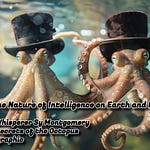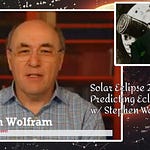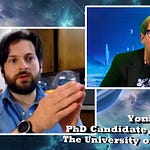Hello everyone!
I hope you are all having an amazing spring!
Today, we are Unraveling Mysteries of the Universe with our special guest, Harry Cliff, physicist from CERN and author of Space Oddities. Let’s dive in!
Once upon a time, astronomers gazed upon Mercury and scratched their heads in wonder. [Hmmm…] This tiny planet had an undeniably wonky orbit, zipping around the Sun in a way that didn’t quite add up. Some scientists were convinced that a hidden planet, aptly named Vulcan, was hiding on the opposite side of the Sun from Mercury.
But, alas, Vulcan remained elusive. Instead, a hero emerged in the form of Albert Einstein and his groundbreaking theory of relativity. Einstein’s genius laid the mystery of Mercury’s weird orbit to rest, revealing that the planet’s strange behavior was a result of spacetime curvature around the massive Sun.
Although the search for Vulcan ultimately led to a dead end, it paved the way for exciting discoveries in our cosmic neighborhood. During the quest for the phantom planet, astronomers stumbled upon numerous unknown asteroids — the rocky remnants from the formation of our solar system.
So, the next time you gaze upon Mercury’s crisp white glow, remember the tale of its odd orbit and the cosmic detective story that unfolded in its wake.
Supersymmetry is a theoretical concept that aims to fill in the gaps of our current understanding of matter at its tiniest detail. It proposes that every known particle has an undiscovered “superpartner” with similar properties but differing spins and masses. The existence of these superpartners could help explain why certain forces and particles behave the way they do.
However, experiments, including some undertaken at the Large Hadron Collider, have yet to find direct evidence of supersymmetry, leading to anomalies that might challenge this theory.
While some physicists argue that supersymmetry might not lie at the foundations of matter after all, others insist it’s merely a matter of adjusting the theory or continuing the search. As the quest for a complete understanding of the Cosmos continues, supersymmetry remains an enticing mystery.
Next up, we talk with Harry Cliff, physicist at CERN, about the strangest anomalies in the Universe, and his new book, Space Oddities.
Welcome to the exciting world of beauty quarks at the Large Hadron Collider’s LHCb experiment!
Matter is made up of atoms containing electron clouds surrounding nuclei of protons and neutrons. These latter particles are, themselves, composed of smaller constituent particles called quarks, which come in six varieties.
Bottom quarks, nicknamed “beauty quarks,” are not typically found in nature, but are produced by particle accelerators like CERN.
Oddly, beauty quarks aren’t decaying as expected, and it’s got physicists scratching their heads. Again.
These anomalies might hint at undiscovered particles or a new force, challenging our understanding of the universe.
Typically, there are four known forces in play throughout the Universe. There is gravity, holding us to our seats, and electromagnetism, providing us with light, radio, and the joy of playing with magnets.
The other two forces are the strong force, which holds the nucleus of atoms together, and the weak force, which releases electrons called beta radiation.
Sub-atomic particles called muons have an identical charge to electrons, but can possess 200 times their mass.
The standard model of physics — one of the mainstays of science — suggests that beauty quarks should decay into equal numbers of muons and electrons. [HOWEVER!!!] these decays unexplainably form more electrons than muons.
Researchers have uncovered evidence that muons might reveal an unseen particle called leptoquarks, or… maybe an odd new force of nature!
Now, most astronomers today agree that the Universe is expanding, and the further away galaxies are, the faster they are traveling. This begs the question, how fast is that?
[O.S. Yeah — how fast is that?]
There are two ways to figure this out. One is to examine the cosmic microwave background radiation (or CMB), an echo from the Big Bang. This serves as a “baby picture” of the Cosmos. The second way is to measure the distances to galaxies using predictable Cepheid variable stars, figure out their distance, measure their velocities, and you get your answer.
A number of extremely precise measurements have been made each way, and they… don’t agree with one another.
The Hubble tension — a clash between observations of the early universe and current measurements of its expansion rate — implies we may need to rethink dark energy, dark matter, and/or gravity’s role in the universe.
None of these intriguing anomalies has presented proof of unknown forces or particles in the Universe. However, they do give us a glimpse of the great questions of physics to be unraveled in the coming decades.
Next week, we are offering up an eclipse viewing guide for the solar eclipse coming to North America on 8 April. Make sure to join us two days before, on Saturday the 6th, and learn how to best see this rare event.
Please subscribe, share, follow, and tell your friends about the show. It’d be much appreciated.
Clear skies!
James
VIP SUBSCRIBERS: Check out some outtake photos below!
Listen to this episode with a 7-day free trial
Subscribe to The Cosmic Companion w/ James Maynard to listen to this post and get 7 days of free access to the full post archives.



















